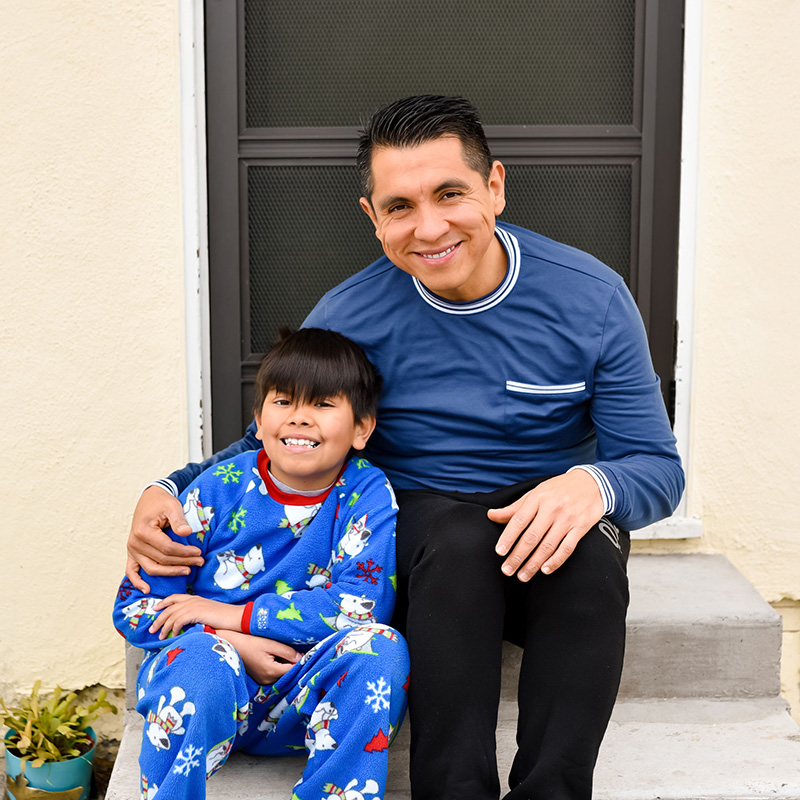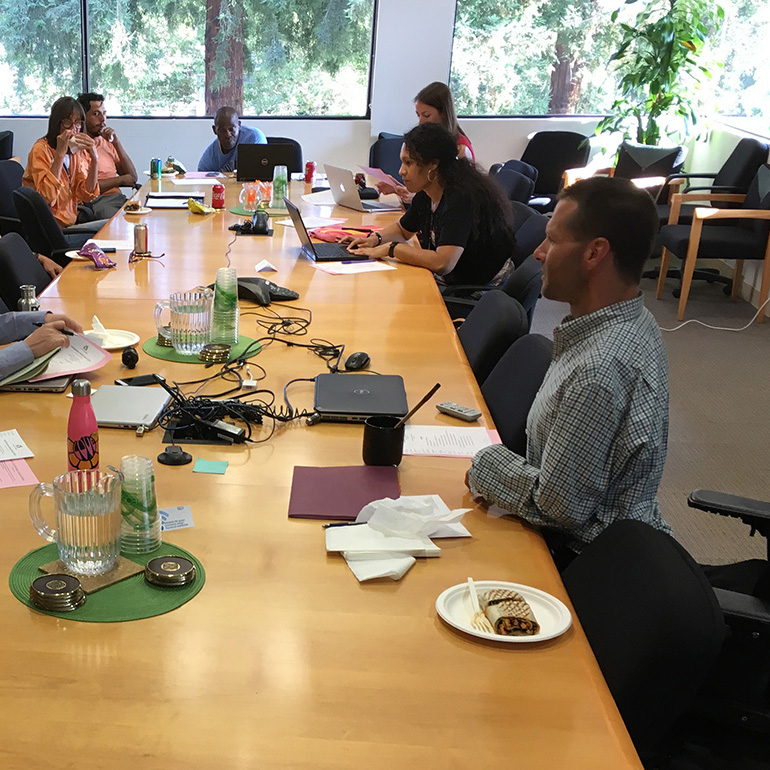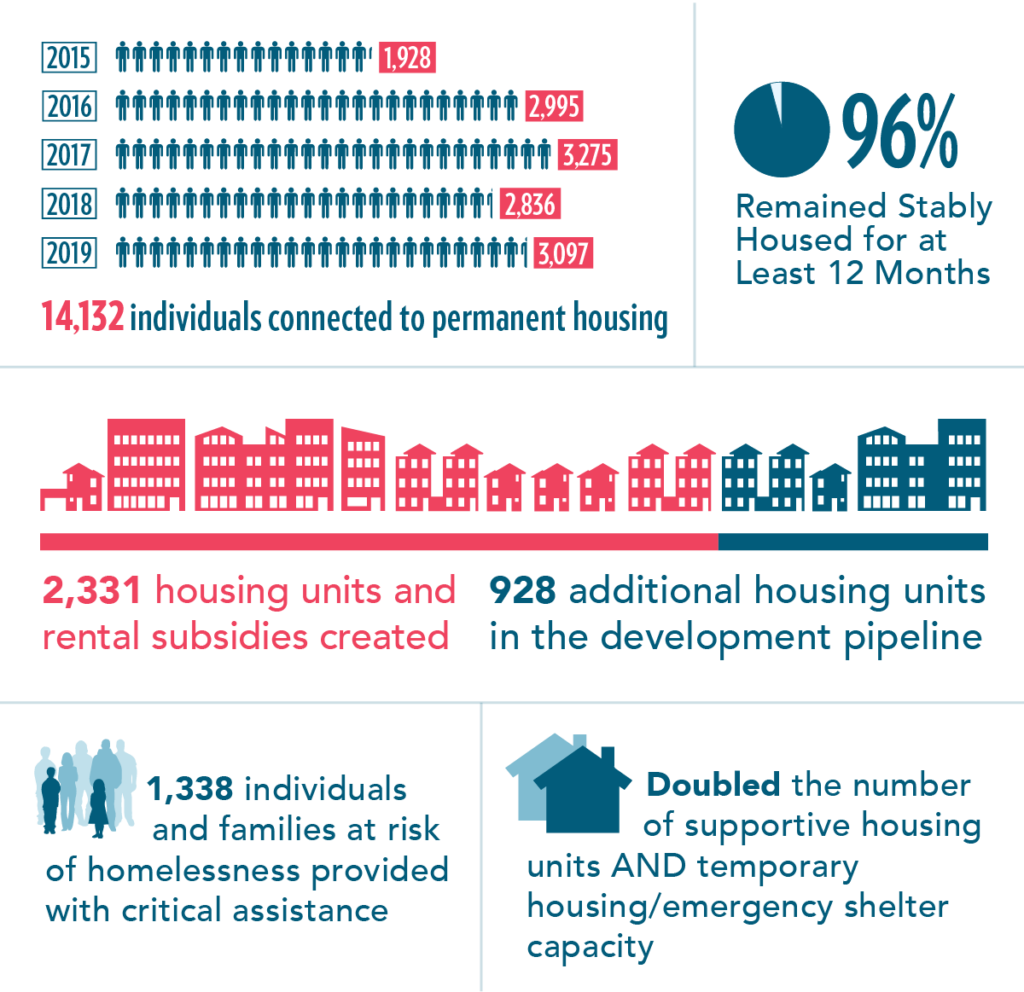(2015 – 2019)
Catalyzing Bold Investments
With a strategic plan in place and some early successes using the Housing FirstThe Housing First approach prioritizes providing permanent housing to people experiencing homelessness, thus ending their homelessness and serving as a platform from which they can pursue personal goals and improve their quality of life. This approach is guided by the belief that people need basic necessities like food and a place to live before attending to anything less critical, such as getting a job, budgeting properly, or attending to substance use issues. The Housing First approach has been validated by numerous rigorous studies — with evidence indicating that, compared to a “treatment first” model, it leads to greater long-term housing stability.
model, the coalition was ready to double down on efforts to end homelessness. But, even as these efforts ramped up, housing options were becoming even more scarce — especially those that were affordable to the community’s lowest-income residents. At the time, the California Housing Partnership estimated that more than 67,500 additional homes were needed to meet the needs of extremely low-income and very low-income residents across Santa Clara County. As a result, the coalition had to move aggressively to secure the funding, political will and partnership needed to scale its work.
Securing New Sources of Funding
With a new shared Community Plan in place, the coalition had a roadmap for moving forward. But it had not yet secured the funding necessary to really start investing in these strategies.
The first key piece of the puzzle came in 2016, when the County of Santa Clara proposed and secured approval for a $950 million affordable housingSubsidized housing where rents are set at a below-market rate based on the tenant’s income. There are many different types of affordable housing — units are typically designated based on a tenant’s income level (i.e., low-income vs. extremely low-income) and certain types of affordable housing may also be reserved for a specific demographic (i.e., seniors or veterans). Deeply affordable housing refers to developments or units where rents are kept particularly low and are intended to serve the lowest-income residents in the community. bond (known as Measure A) that created a large dedicated source of funding to build more deeply affordable housing. Other public entities would follow suit too – the Santa Clara County Housing Authority began allocating housing vouchers and other federal resources to the effort, and the City of San Jose aligned many of its existing resources, as well as a 2020 transfer tax (known as Measure E) behind this collective work – adding several hundreds of millions of additional private dollars. In addition, Destination: Home launched a years-long effort to raise private and philanthropic funding, ultimately bringing in more than $300 million in additional private funding.
Together, these key sources of funding would make it possible for the coalition to begin advancing its efforts at-scale.
Key Initiatives Launched During This Period
As these key sources of funding were secured, the coalition was able to launch several key strategies between 2015 and 2020 – all of which continue to this day and have served as the foundation for the community-wide effort to end homelessness

Ramping Up the Production of Deeply Affordable Housing
After the adoption of the Measure A housing bond in 2016, the coalition undertook a concerted strategy to ramp up production and development of deeply affordable housing in Santa Clara County – and particularly extremely low income and supportive housingA type of housing unit or program that combines affordable housing with support services (for example, mental health, employment, or peer support services) that has proven successful in helping homeless individuals become and stay housed. Supportive housing programs can come in many forms, including long-term programs (i.e., Permanent Supportive Housing) and shorter-term support (i.e., Rapid Rehousing). units. Yet the voters’ stamp of approval was not enough; truly scaling up deeply affordable housing production also required aligning members throughout the coalition.
By coming together around this shared goal, the coalition has successfully launched more than 64 new housing developments with more than 7,000 affordable units over the past decade.

Launching a New Homelessness Prevention System
From the start, the coalition’s primary focus was to produce more affordable housing and get more people into those homes. But over time, it became clear that these efforts needed to be complemented by efforts to prevent more families from being pushed into homelessness in the first place. And helping families stay in their existing homes costs much less — both financially and in terms of suffering — than assisting people once they are pushed out of their homes.
So, in 2017, the coalition brought a wide array of public, private and nonprofit partners together to launch a new Homelessness Prevention System. And over the next half-dozen years, this system would ultimately serve 20,000 people at risk of homelessness — more than 90% of whom remained stably housed — and become a key part of the local homelessness response.

Centering Lived Experience in Our Work
Too often, people with lived experience of homelessness are treated only as beneficiaries, rather than key constituents of, and advisors to, the system of care. As the model in Santa Clara County evolved, it was abundantly clear that voices of lived experience should be front and center and the coalition took intentional steps to center lived experience in its work.
Today, a half-dozen different decision-making bodies include dedicated seats for people with lived experience and, over the years, hundreds of millions of dollars in publicly-funded homelessness contracts have been vetted by people with lived experience.
Key Metrics from the 2015-2020 Community Plan
Thanks to the key efforts described above, and many other key initiatives, the coalition delivered many impressive results during the 2015-2020 Community Plan period:

Key Elements for Successful Coalition Building
“Coalition” is a deceptively simple word. Reams of research, case studies, even university courses are dedicated to the art of building a coalition, because forming a solid, sustained partnership around a common agenda is extremely hard work. What’s more, each coalition looks different—with varying stakeholders, priorities, power dynamics, and decision-making structures.
Collective impactA concept first introduced in the Stanford Social Innovation Review in 2011, collective impact is a framework for deep and sustained collaboration between actors from different sectors to solve a specific social problem. Successful collective impact initiatives include a common agenda, shared measurement systems, mutually reinforcing activities, continuous communication, and backbone support organizations. starts from the assumption that working together is more effective than working alone. So how do you bring together groups with different perspectives, agendas, and resources and convince them to move in a shared direction? In this collective impact model, several elements were critical to building a functional coalition. No coalition is without conflict, but the elements below can help stakeholders align their priorities, build trusting relationships, and allocate resources for the greater good.
Sometimes if you lack clarity about the role your agency can play or can’t play, that starts creating friction points. What works for us is a constant communication loop.
Preston Prince, Executive Director of
Santa Clara County Housing Authority
I’m sitting in meetings next to billionaires, entrepreneurs, people with lived experience, and county leadership. That’s really unique for service providers, who are typically relegated to operational-level participation in the system.
Louis Chicoine, CEO of Abode Services







